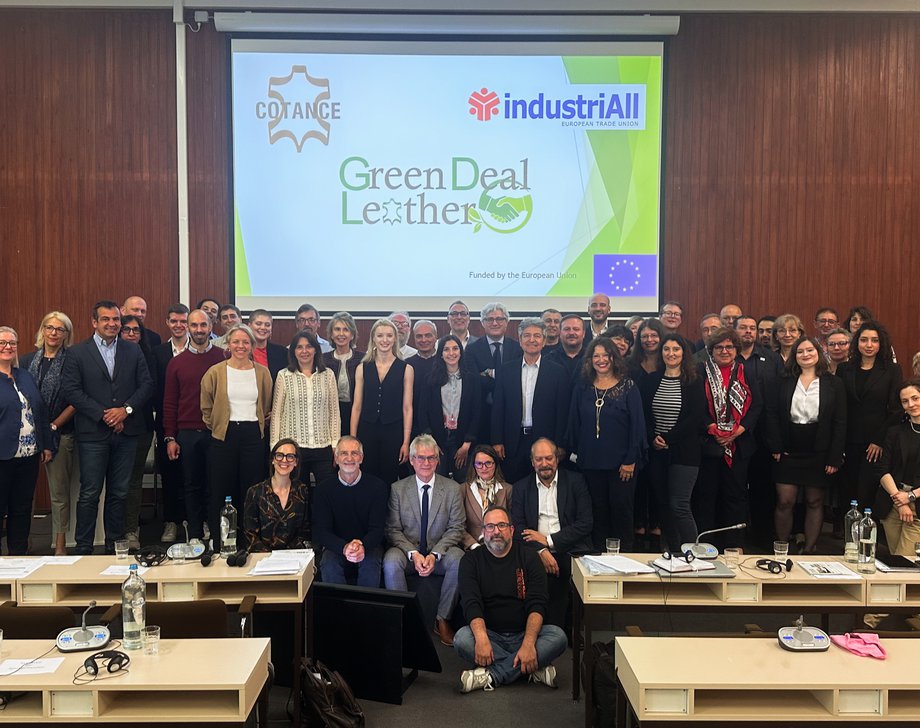Today in Brussels, the European Tanning and Leather social partners, COTANCE and industriAll Europe held the Green Deal Leather Final Conference, concluding a two-year, EU-funded Social Dialogue project ’Towards Zero Adverse Impact of the European Leather Industry – GREEN DEAL LEATHER’.
The event attracted around 100 on-site attendees and marked the end of a successful, EU-funded social dialogue project between the European social partners as well as national representatives from Spain (ACEXPIEL), Portugal (APIC), France (FFTM), Hungary (MKZS), Italy (UNIC), Germany (VDL), and Austria (FVTBSL).
The Final Conference commenced with an address by Judith Kirton-Darling, Secretary General of industriAll Europe, who stated: “We have a proud tradition of producing good quality leather here in Europe and we want to make the leather sector, like all manufacturing sectors, as green as possible. At the same time, good occupational health and safety practices in the workplace, with ongoing training and checks, are essential for achieving a more sustainable leather industry. Social dialogue is key, and with the project’s preliminary results serving as a baseline, we must now work together to achieve zero accidents.’’
Mr Manuel Rios, President of COTANCE, added: "Through the Green Deal Leather project, COTANCE continues to equip European tanners with the tools and intelligence needed to progress towards a more sustainable future. We believe that transparency is key to advancing our social and environmental credentials and dispelling common misconceptions about leather. We are proud to undertake this journey hand in hand with our social partners.”
Following the opening remarks, COTANCE Secretary General, Mr. Gustavo González-Quijano, introduced the audience to the GDL project. Representative data on tannery workplace safety in the EU ("Injuries/Incidents at the Workplace" study released in Lineapelle/Milan, September 19, 2023) and the carbon footprint of leather ("The Carbon Footprint of European Bovine Leather" study released at the Final Conference in Brussels) were screened in two infographic videos. The data obtained serves as both a benchmark and a baseline, supporting sustainable development within the European tanning industry.
The studies reveal that:
- Tannery-related accidents in EU countries surveyed (Italy, Spain, France, Germany, Portugal, Hungary and Austria) declined by 16%, from 1,317 in 2019 to 1,102 in 2021. However, with an incidence rate of 3.2% in 2021, of which 15% is on the way to/from work, and over 90% of recorded accidents being qualified as of "minor" severity, there is still room for improvement.
- Calculating leather's carbon footprint is a complex exercise that requires a thorough understanding of the tanning industry, its processes and The result obtained with the ECO2L method indicates an average of 8kg of CO2 per m2 of bovine leather in tannery processes. This figure can vary based on specific characteristics of the leather, such as thickness and performance requirements. Therefore, since each batch of leather is made to order, customers have the opportunity to influence the eco-design of their leather products.
- Leather's environmental impact stems more from livestock breeding and chemicals than from tanning. The study also shows why replacing a chemical with one that has a lower carbon footprint does not always result in overall improvement.
Following the presentation, the first panel, moderated by Elspeth Hathaway of industriAll Europe, featured Agostino Apolito, Director General of Assomac; Beatriz Mello da Cunha, Specialist at ILO; Javier Uson Montesinos, Representative at UGT-FICA; and Sabrina Frontini, Director of ICEC, who together provided valuable insights into the social sustainability of the leather industry.
Speakers emphasised that prevention strategies, including health & safety certification and training, Personal Protective Equipment (PPE), and active worker involvement are crucial to enhancing workplace safety. Quality social dialogue is an effective tool for discussing workplace issues and ensuring all workers are safe. Additionally, with challenges in attracting young people to the sector, it is important to demonstrate that the tanning and leather industry is not only safe but also green and circular.
The second panel featured top leather industry experts: Dr Francesco Troisi, head of the CERIS srl Analytical Laboratory and member of the UNPAC Technical Commission; Andreas Meyer, Managing Director of VDL; Ivan Kral, Industrial Development Officer of UNIDO; and Guido Zilli, ESG Manager of Gruppo Mastrotto. Christian Baio, Sustainability & Business Development Manager, Spin360°, moderated the panel.
Building on previous achievements and leather's natural properties, from its durability and life-cycle assessment, discussed by Ivan Kral, to the dysfunction of the EF methodology and its penalising effects, presented by Guido Zilli, the second panel highlighted leather's inherent sustainability, making it an ideal component of the circular economy. The ECO2L carbon footprint calculation tool, introduced today, marks a further step towards a harmonised approach and increased transparency in the industry. Future steps will develop aspects like durability, natural content, and reparability to enable accurate comparisons of different materials and their true environmental footprints.
The Final Conference of the GDL project showcased the work and achievements of the social partners, who, in these last two years, have gathered and produced data that will greatly benefit the tanning and leather sector globally. By working together in social dialogue, the European leather industry produces tools and intelligence which contribute to worker safety, protect the environment, and promote sustainable, high-quality leather, supporting millions of jobs worldwide.


